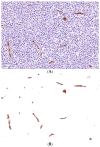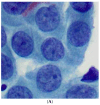Image Analysis in Histopathology and Cytopathology: From Early Days to Current Perspectives
- PMID: 39452415
- PMCID: PMC11508754
- DOI: 10.3390/jimaging10100252
Image Analysis in Histopathology and Cytopathology: From Early Days to Current Perspectives
Abstract
Both pathology and cytopathology still rely on recognizing microscopical morphologic features, and image analysis plays a crucial role, enabling the identification, categorization, and characterization of different tissue types, cell populations, and disease states within microscopic images. Historically, manual methods have been the primary approach, relying on expert knowledge and experience of pathologists to interpret microscopic tissue samples. Early image analysis methods were often constrained by computational power and the complexity of biological samples. The advent of computers and digital imaging technologies challenged the exclusivity of human eye vision and brain computational skills, transforming the diagnostic process in these fields. The increasing digitization of pathological images has led to the application of more objective and efficient computer-aided analysis techniques. Significant advancements were brought about by the integration of digital pathology, machine learning, and advanced imaging technologies. The continuous progress in machine learning and the increasing availability of digital pathology data offer exciting opportunities for the future. Furthermore, artificial intelligence has revolutionized this field, enabling predictive models that assist in diagnostic decision making. The future of pathology and cytopathology is predicted to be marked by advancements in computer-aided image analysis. The future of image analysis is promising, and the increasing availability of digital pathology data will invariably lead to enhanced diagnostic accuracy and improved prognostic predictions that shape personalized treatment strategies, ultimately leading to better patient outcomes.
Keywords: cytopathology; digital image analysis; microscopy; pathology.
Conflict of interest statement
The authors declare no conflicts of interest.
Figures






Similar articles
-
Digital pathology and artificial intelligence.Lancet Oncol. 2019 May;20(5):e253-e261. doi: 10.1016/S1470-2045(19)30154-8. Lancet Oncol. 2019. PMID: 31044723 Free PMC article. Review.
-
Future Practices of Breast Pathology Using Digital and Computational Pathology.Adv Anat Pathol. 2023 Nov 1;30(6):421-433. doi: 10.1097/PAP.0000000000000414. Epub 2023 Sep 22. Adv Anat Pathol. 2023. PMID: 37737690
-
Towards Artificial Intelligence Applications in Next Generation Cytopathology.Biomedicines. 2023 Aug 8;11(8):2225. doi: 10.3390/biomedicines11082225. Biomedicines. 2023. PMID: 37626721 Free PMC article.
-
Revolutionizing Digital Pathology With the Power of Generative Artificial Intelligence and Foundation Models.Lab Invest. 2023 Nov;103(11):100255. doi: 10.1016/j.labinv.2023.100255. Epub 2023 Sep 26. Lab Invest. 2023. PMID: 37757969 Review.
-
Histopathological Images Analysis and Predictive Modeling Implemented in Digital Pathology-Current Affairs and Perspectives.Diagnostics (Basel). 2023 Jul 14;13(14):2379. doi: 10.3390/diagnostics13142379. Diagnostics (Basel). 2023. PMID: 37510122 Free PMC article. Review.
Cited by
-
Advancements in Digital Cytopathology Since COVID-19: Insights from a Narrative Review of Review Articles.Healthcare (Basel). 2025 Mar 17;13(6):657. doi: 10.3390/healthcare13060657. Healthcare (Basel). 2025. PMID: 40150507 Free PMC article. Review.
-
Machine learning assisted classification of staphylococcal biofilm maturity.Biofilm. 2025 May 2;9:100283. doi: 10.1016/j.bioflm.2025.100283. eCollection 2025 Jun. Biofilm. 2025. PMID: 40458267 Free PMC article.
-
Challenges and Opportunities in Cytopathology Artificial Intelligence.Bioengineering (Basel). 2025 Feb 13;12(2):176. doi: 10.3390/bioengineering12020176. Bioengineering (Basel). 2025. PMID: 40001695 Free PMC article. Review.
-
Construction of a Multimodal Machine Learning Model for Papillary Thyroid Carcinoma Based on Pathomics and Ultrasound Radiomics Dataset.Data Brief. 2025 Apr 28;60:111583. doi: 10.1016/j.dib.2025.111583. eCollection 2025 Jun. Data Brief. 2025. PMID: 40534709 Free PMC article.
-
Vision Transformers for Low-Quality Histopathological Images: A Case Study on Squamous Cell Carcinoma Margin Classification.Diagnostics (Basel). 2025 Jan 23;15(3):260. doi: 10.3390/diagnostics15030260. Diagnostics (Basel). 2025. PMID: 39941191 Free PMC article.
References
Publication types
LinkOut - more resources
Full Text Sources

